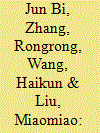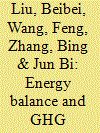|
|
|
Sort Order |
|
|
|
Items / Page
|
|
|
|
|
|
|
| Srl | Item |
| 1 |
ID:
109321


|
|
|
|
|
| Publication |
2011.
|
| Summary/Abstract |
The development of urbanization is accelerating in China, and there are great pressures and opportunities in cities to reduce carbon emissions. An emissions inventory is a basic requirement for analyzing emissions of greenhouse gases (GHGs), their potential reduction and to realize low-carbon development of cities. This study describes a method to establish a GHGs emissions inventory in Chinese cities for 6 emission sources including industrial energy consumption, transportation, household energy consumption, commercial energy consumption, industrial processes and waste. Nanjing city was selected as a representative case to analyze the characteristics of carbon emissions in Chinese cities. The results show that carbon emissions in Nanjing have increased nearly 50% during the last decade. The three largest GHGs contributors were industrial energy consumption, industrial processes and transportation, which contributed 37-44%, 35-40% and 6-10%, respectively, to the total GHGs emissions. Per GDP carbon emissions decreased by 55% from 2002 to 2009, and the per capita and per GDP carbon emissions were comparable or even lower than the world average levels. These results have important policy implications for Chinese cities to control their carbon emissions.
|
|
|
|
|
|
|
|
|
|
|
|
|
|
|
|
| 2 |
ID:
098691


|
|
|
|
|
| Publication |
2010.
|
| Summary/Abstract |
Data envelopment analysis (DEA) has recently become a popular method in measuring energy efficiency at the macro-economy level. However, previous studies are limited in that they failed to consider the issues of undesirable outputs and minimisation of energy consumption. Thus, this study considers both factors in measuring Chinese industrial energy efficiency and investigates the maximum energy-saving potential in 28 administrative regions in China. The results show that industries in the east area have the best average energy efficiency for the period 2000-2006, followed by the central area. Further, after comparing the industrial energy overall efficiency, pure technical efficiency (IEPTE), and scale efficiency of the 28 administrative regions examined, the study finds that in most regions of this study, the two main reasons causing the wastage of a large amount of energy during the industrial production process are that the industrial structure of most regions still relies on the massive use of energy in order to support the industrial-based economy and the IEPTE is too low. Based on these findings, this paper correspondingly proposes some policies to improve regional industrial energy efficiency.
|
|
|
|
|
|
|
|
|
|
|
|
|
|
|
|
| 3 |
ID:
121279


|
|
|
|
|
| Publication |
2013.
|
| Summary/Abstract |
Cassava-based fuel ethanol (CFE) is playing an increasingly important role in renewable transportation energy in the Guangxi Province in China. Previous studies have evaluated the energy and greenhouse gas (GHG) performance of CFE, but they have largely overlooked the influences of different agricultural planting modes. In this study, five scenarios related to cassava planting modes were selected to evaluate the lifecycle energy balance and GHG emissions of the CFE system. The results show that, although all the five CFE scenarios show positive net energy values (NEV) and GHG emissions savings compared with the conventional gasoline, the planting modes have significant impacts on their energy and GHG performance. Modes that are considered intensive (i.e. high fertilizer use intensity and highly mechanized harvesting) generally show poorer performance than the extensive ones, primarily because of the intensive energy consumption and GHG emissions during nitrogen fertilizer production, the N2O emission of nitrogen fertilizer use, and higher yield loss rate caused by mechanized harvesting. This study shows that it is important to evaluate the planting modes when producing bioethanol in order to gain an understanding of the life-cycle energy use and GHG performance.
|
|
|
|
|
|
|
|
|
|
|
|
|
|
|
|
|
|
|
|
|